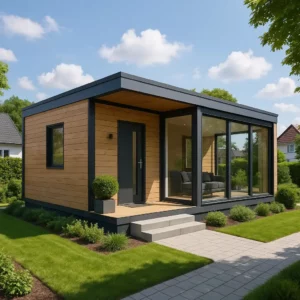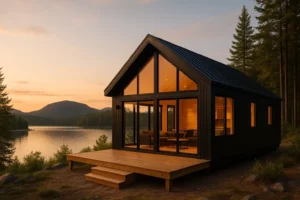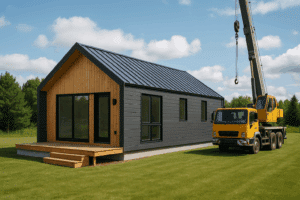Building your own prefabricated (or manufactured) home in Quebec is an exciting project. Quick to manufacture, often more economical and environmentally friendly, these homes offer numerous advantages.
But be careful : like any construction project, there may be unforeseen events along the way. Schedule delays, logistical challenges, unpredictable weather, administrative red tape, installation errors – all potential surprises that can catch new self-builders off guard.
The purpose of this article is to provide you educate in an accessible way on these unforeseen events, to explain their causes, and to give you practical advice to prepare for itConcrete examples will illustrate each point, so that you can start your prefabricated house project with peace of mind.
In this article, we answer common questions and guide you to anticipate possible problems during a machined build.
✨ Are you looking for the perfect manufactured home in Quebec? Discover it now on our platform! ✨
🛡️ Protect your investment and simplify your project thanks to our insurance partner Norga: quickly obtain advice and compare the best insurance offers from today! 🛡️
Why are there still unforeseen events with a manufactured home?
A manufactured home is built in a factory in a controlled environment, then delivered and assembled on your lot.
This process greatly reduces the risks compared to traditional construction.
For example, factory manufacturing is not delayed by the weather and most materials are prepared in advance, eliminating many unforeseen delays.
However, no project is completely safe from surprises. Some steps (transport, installation on site, connections, etc.) still depend on external factors. It is therefore important to be aware of unforeseen events. specific to prefabricated houses to better prepare for it.
In summary: Prefabricated housing reduces risks, but it doesn't eliminate them completely. The following sections describe the most common unforeseen events—delays, transportation issues, weather, permits, and installation errors—their main causes, real-life examples, and tips for anticipating or mitigating these risks. Prevention is better than cure!
Problems with transport and delivery of modules
Transporting your prefabricated home modules from the factory to the construction site involves several risks to anticipate. A poorly planned route can cause significant delays or property damage.
Main risks
Transporting oversized modules requires careful planning to avoid low bridges, narrow or winding roads and requires special permits.
A poorly judged route can lead to serious incidents, such as a module hitting a viaduct, or delays due to breakdowns, unforeseen bad weather or authorizations not obtained in time.
Upon arrival, coordination problems with the crane or difficult-to-access terrain can also complicate delivery.
Practical advice
- Choose experienced carriers : Check that your manufacturer works with a specialized carrier who knows the route, anticipates potential obstacles and possibly has an escort vehicle.
- Validate the necessary authorizations : Confirm that all special permits (exceptional convoys, police escorts) are obtained before departure. Unauthorized transport may be stopped en route.
- Watch the weather : Check the weather conditions before delivery. If bad weather is forecast, it is best to postpone the shipment to avoid any risks.
- Prepare access to the construction site : Ensure that access to the site is clear and wide enough. Anticipate and adjust any potential obstacles (tree branches, fences, etc.) in advance to facilitate truck and crane maneuvers.
- Check transport insurance : Make sure your home has specific insurance coverage during transport. Check with your manufacturer or insurer to ensure you're covered in the event of an incident.
Trick : Make your life easier! Thanks to our partner Norga, you can quickly compare insurance offers and get advice for all stages of your project!
Unforeseen events related to weather conditions
In Quebec, the weather can cause unforeseen events on a manufactured home construction site, particularly for excavation, foundations, delivery and assembly of the modules.
In winter, frost complicates foundation work, and a snowstorm can block delivery. In spring, heavy rain soaks the ground and prevents construction. Strong winds make assembly risky, while heat waves slow down some projects and tire teams.
Concrete example: An unforeseen storm in November blocks delivery for a week, causing cascading delays on the construction site (electrician, plumber, etc.).
Factory construction, however, offers valuable flexibility to avoid these problems, particularly by carrying out as much work as possible during the winter, ready for delivery the following spring.maisonusinex.com)
Practical advice:
-
Plan outdoor steps during favorable periods (spring, summer).
-
Protect the site (tarpaulins against rain, heating the concrete, early snow removal).
-
Stay flexible and adjust your schedule according to the weather.
-
Check that your construction insurance covers damage due to bad weather.
Building permits and administrative procedures
Administrative procedures are often underestimated by self-builders. Before starting work, you will need to obtain a building permit from your municipality and possibly other specific authorizations (site certificate, environmental approval, etc.). These procedures can take longer than expected and cause delays.
Administrative delays
The average time to obtain an initial response to a permit application is approximately 30 days (e.g. Quebec City). This period may extend by an additional 30 to 60 days in the presence of special features such as a heritage zone or sloping terrain. Therefore, allow several weeks to 2-3 months in complex cases. Until the permit is issued, you cannot begin construction.
Unforeseen requirements
The municipality may require additional adjustments or documents before granting a permit: soil study (percolation), plans sealed by an engineer, compliance with urban planning criteria (maximum height, setbacks from property lines, imposed aesthetics, etc.). Minor modifications or variances may be necessary, resulting in additional delays and costs.
Practical advice
- Inform yourself early Before purchasing your land or choosing a model, check with the municipality regarding local regulations, administrative procedures, and any restrictions.
- Anticipate your request : Submit your application quickly, even with preliminary plans. This allows you to move forward simultaneously with manufacturing and administrative validation.
- Prepare a complete file Verify that all required documents, certificates, and technical plans (with professional seals, if necessary) are included. A clear and complete file facilitates and expedites administrative processing.
- Don't forget the related permissions : Also anticipate requests for connections (electricity, water supply, telecoms), installation of wells or septic tanks, soil tests and additional permits (driveway entrance).
By carefully preparing your administrative procedures, you will avoid unnecessary delays in the completion of your prefabricated house project.
Other unforeseen events and conclusion: prepare for every eventuality
Every construction project involves an element of the unexpected: unforeseen discoveries on site, unforeseen expenses, or supplier delays. The key is to be flexible, proactive, and to build in a contingency (10% of the budget plus a few extra weeks).
Some insurance policies can mitigate these risks (construction site, home, manufacturer's warranty). Consult our dedicated article and make an appointment with an expert Norga to compare more than 20 insurers for free.
Building a prefabricated home in Quebec is a wonderful adventure. Well-informed and prepared, you can begin your project with confidence. Happy building!
✨ Protect your investment and simplify your project with our Norga insurance partner : quickly get advice and compare the best insurance offers from today! ✨




